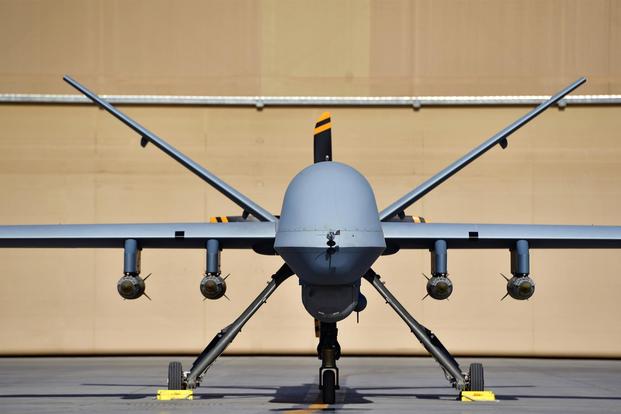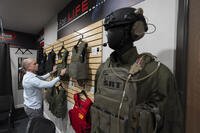Go out for strikes first, gather intel later. It's the way officials are sending out the MQ-9 Reaper drone for a new, tailored multi-role mission to strike Taliban targets in Afghanistan.
A single medium-altitude unmanned Reaper on Thursday dropped four 500-pound precision guided weapons on a Taliban narcotics facility in Helmand Province, destroying its targets, Air Forces Central Command said in a release Monday.
AfCent officials said the "historic multirole missions in the deliberate air campaign" are in line with this new approach to execute "deliberate strikes, armed overwatch or close air support missions, and then [flex] to an [intelligence, surveillance and reconnaissance] tasking - all in a single mission."
Officials added that the strategy gave planners more flexibility to choose the right strike platform, manned or unmanned. The available options include F-16 Fighting Falcons; B-52 Stratofortresses; A-10 Thunderbolt IIs; and MQ-9s, AfCent said.
Related content:
- Air Force Wants to Decrease Manning for Its UAVs
- 'Hunter-Killer' Reaper Drone Taking On More Strike Missions in Afghanistan
- MQ-9 Reapers Heading to Florida as Air Force Expands Drone Fleet
The announcement comes a few weeks after the the B-52 set another record for the number of smart bombs dropped on Taliban facilities.
The iconic bomber played a leading role against the extremist group earlier this month, striking the Taliban's training facilities in Badakhshan province near the border of China and Tajikistan with 24 smart bombs, U.S. Forces-Afghanistan said in a release. That's up from a previous record set in November of 19 precision-guided munitions dropped.
The MQ-9 as a platform has steadily been adding to the Air Force's strike tally in the region.
As the service slowly begins to phase out its MQ-1 Predator unmanned aerial vehicle, the larger, more lethal MQ-9 is stepping up its missions.
For example, when the military mission in Afghanistan transitioned from Operation Enduring Freedom to the NATO-led Resolute Support, the MQ-9's missions increased tenfold in comparison to the MQ-1.
The Reaper conducted 950 strikes, shooting off approximately 1,500 weapons, between Jan. 2015 and Aug. 2017, according to AfCent statistics provided to Military.com. The MQ-1 executed only 35 strikes, employing roughly 30 weapons, in that same timeframe.
In June, the Air Force sent out its first MQ-9 Block 5 variant -- which features updated electrical and communications systems, and works with the new Block 30 cockpit -- to support operations against the Islamic State in Iraq and Syria.
The MQ-1 can carry two AGM-114 Hellfires; the MQ-9, by comparison, has a payload of 3,750 pounds, and carries a combination of AGM-114 Hellfire missiles, GBU-12 Paveway II and GBU-38 Joint Direct Attack Munitions, according to the Air Force.
The Air Force is pushing to move to an all-MQ-9 remotely piloted combat aircraft fleet following the planned retirement of the MQ-1 on March 9.
-- Oriana Pawlyk can be reached at oriana.pawlyk@military.com. Follow her on Twitter at @oriana0214.
Related Video:










